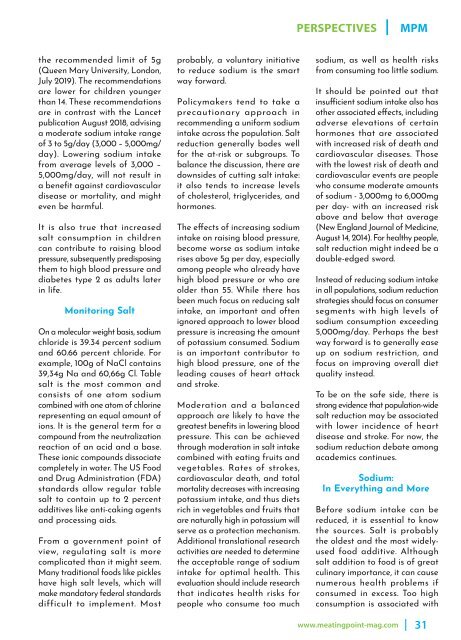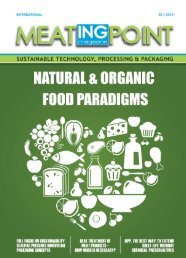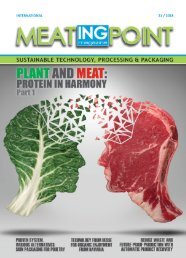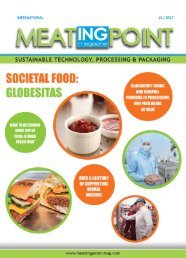MEATing POINT Magazine: #27 / 2019
You also want an ePaper? Increase the reach of your titles
YUMPU automatically turns print PDFs into web optimized ePapers that Google loves.
PERSPECTIVES | MPM<br />
the recommended limit of 5g<br />
(Queen Mary University, London,<br />
July <strong>2019</strong>). The recommendations<br />
are lower for children younger<br />
than 14. These recommendations<br />
are in contrast with the Lancet<br />
publication August 2018, advising<br />
a moderate sodium intake range<br />
of 3 to 5g/day (3,000 – 5,000mg/<br />
day). Lowering sodium intake<br />
from average levels of 3,000 –<br />
5,000mg/day, will not result in<br />
a benefit against cardiovascular<br />
disease or mortality, and might<br />
even be harmful.<br />
It is also true that increased<br />
salt consumption in children<br />
can contribute to raising blood<br />
pressure, subsequently predisposing<br />
them to high blood pressure and<br />
diabetes type 2 as adults later<br />
in life.<br />
Monitoring Salt<br />
On a molecular weight basis, sodium<br />
chloride is 39.34 percent sodium<br />
and 60.66 percent chloride. For<br />
example, 100g of NaCl contains<br />
39,34g Na and 60,66g Cl. Table<br />
salt is the most common and<br />
consists of one atom sodium<br />
combined with one atom of chlorine<br />
representing an equal amount of<br />
ions. It is the general term for a<br />
compound from the neutralization<br />
reaction of an acid and a base.<br />
These ionic compounds dissociate<br />
completely in water. The US Food<br />
and Drug Administration (FDA)<br />
standards allow regular table<br />
salt to contain up to 2 percent<br />
additives like anti-caking agents<br />
and processing aids.<br />
From a government point of<br />
view, regulating salt is more<br />
complicated than it might seem.<br />
Many traditional foods like pickles<br />
have high salt levels, which will<br />
make mandatory federal standards<br />
difficult to implement. Most<br />
probably, a voluntary initiative<br />
to reduce sodium is the smart<br />
way forward.<br />
Policymakers tend to take a<br />
precautionary approach in<br />
recommending a uniform sodium<br />
intake across the population. Salt<br />
reduction generally bodes well<br />
for the at-risk or subgroups. To<br />
balance the discussion, there are<br />
downsides of cutting salt intake:<br />
it also tends to increase levels<br />
of cholesterol, triglycerides, and<br />
hormones.<br />
The effects of increasing sodium<br />
intake on raising blood pressure,<br />
become worse as sodium intake<br />
rises above 5g per day, especially<br />
among people who already have<br />
high blood pressure or who are<br />
older than 55. While there has<br />
been much focus on reducing salt<br />
intake, an important and often<br />
ignored approach to lower blood<br />
pressure is increasing the amount<br />
of potassium consumed. Sodium<br />
is an important contributor to<br />
high blood pressure, one of the<br />
leading causes of heart attack<br />
and stroke.<br />
Moderation and a balanced<br />
approach are likely to have the<br />
greatest benefits in lowering blood<br />
pressure. This can be achieved<br />
through moderation in salt intake<br />
combined with eating fruits and<br />
vegetables. Rates of strokes,<br />
cardiovascular death, and total<br />
mortality decreases with increasing<br />
potassium intake, and thus diets<br />
rich in vegetables and fruits that<br />
are naturally high in potassium will<br />
serve as a protection mechanism.<br />
Additional translational research<br />
activities are needed to determine<br />
the acceptable range of sodium<br />
intake for optimal health. This<br />
evaluation should include research<br />
that indicates health risks for<br />
people who consume too much<br />
sodium, as well as health risks<br />
from consuming too little sodium.<br />
It should be pointed out that<br />
insufficient sodium intake also has<br />
other associated effects, including<br />
adverse elevations of certain<br />
hormones that are associated<br />
with increased risk of death and<br />
cardiovascular diseases. Those<br />
with the lowest risk of death and<br />
cardiovascular events are people<br />
who consume moderate amounts<br />
of sodium - 3,000mg to 6,000mg<br />
per day- with an increased risk<br />
above and below that average<br />
(New England Journal of Medicine,<br />
August 14, 2014). For healthy people,<br />
salt reduction might indeed be a<br />
double-edged sword.<br />
Instead of reducing sodium intake<br />
in all populations, sodium reduction<br />
strategies should focus on consumer<br />
segments with high levels of<br />
sodium consumption exceeding<br />
5,000mg/day. Perhaps the best<br />
way forward is to generally ease<br />
up on sodium restriction, and<br />
focus on improving overall diet<br />
quality instead.<br />
To be on the safe side, there is<br />
strong evidence that population-wide<br />
salt reduction may be associated<br />
with lower incidence of heart<br />
disease and stroke. For now, the<br />
sodium reduction debate among<br />
academics continues.<br />
Sodium:<br />
In Everything and More<br />
Before sodium intake can be<br />
reduced, it is essential to know<br />
the sources. Salt is probably<br />
the oldest and the most widelyused<br />
food additive. Although<br />
salt addition to food is of great<br />
culinary importance, it can cause<br />
numerous health problems if<br />
consumed in excess. Too high<br />
consumption is associated with<br />
www.meatingpoint-mag.com | 31
















